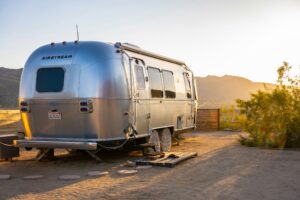Essential Areas To Examine When Buying A Used Camper Or Trailer
 As the spring season arrives, it’s an opportune time to begin searching for a reliable used camper. Whether you’re exploring options at a dealership or considering a purchase from an individual seller on platforms like Craigslist, it’s crucial to know what to look for in terms of potential damage or wear. By paying attention to the following trouble areas, you can save yourself from costly repairs and ensure a satisfactory camper-buying experience.
As the spring season arrives, it’s an opportune time to begin searching for a reliable used camper. Whether you’re exploring options at a dealership or considering a purchase from an individual seller on platforms like Craigslist, it’s crucial to know what to look for in terms of potential damage or wear. By paying attention to the following trouble areas, you can save yourself from costly repairs and ensure a satisfactory camper-buying experience.
Delamination
RVs are typically constructed with laminated plywood and bonded with adhesive. Over time, this adhesive can deteriorate, leading to delamination of the RV’s side. Unfortunately, delamination is a challenging issue to fix inexpensively. Common causes include moisture, heat, or simply aging.
To identify delamination, examine the side of the RV. Look for any changes in the surface, resembling a large bubble. Press your hand against it. Does it flex or feel like there is space between the exterior fiberglass shell and the interior plywood?
Tires
Inspecting the tires is a straightforward task. Look for small cracks between the treads. As RVs sit unused, flat spots and weather cracks can develop on the tires. While these cracks are mostly cosmetic, they can gradually degrade the tire’s integrity. If the tires show signs of wear or cracking, factor this into the overall cost of purchasing the RV.
Rodent Damage
Rodents have a knack for infiltrating various spaces, and your RV or trailer is no exception. In fact, these vehicles provide ideal homes for rodents since they often remain undisturbed for extended periods. When searching for signs of rodents, check beneath seat cushions and inspect storage compartments. Look for droppings, as mice and rats tend to leave them everywhere. Rodent infestation poses both health hazards and potential damage to your RV’s interior.
Water Damage
RVs are highly susceptible to water damage, as many manufacturers in the US may not build them with optimal quality. Water damage is usually easy to detect through smell or visual cues. A musty odor or dampness inside the RV serves as a significant indicator. Look for mineral stains or watermarks on wood surfaces, particularly around skylights and air conditioners on the roof.
Additionally, walk around the RV or trailer and apply pressure to all sides. Water infiltration can quickly lead to structural rot in the RV’s framework. Pushing on the sides can help identify compromised areas. Pay close attention to windows and the roof.
Appliances
Replacing RV appliances can be incredibly expensive due to their compact size and specialized nature. When considering a used RV, request the owner or dealer to start up the refrigerator before your arrival, allowing you to feel its cooling effect. RV refrigerators can run on electricity, battery, or propane. They typically take around two hours to cool down, so ensure it’s turned on in advance.
Additionally, while inspecting the camper, test the functionality of water heaters and any other systems that are important to you.
Canvas
If your trailer or RV features canvas components, closely examine them for signs of mold or staining. Additionally, if any windows are made of plastic, check the zippers and windows for cracks. Replacing the canvas top of a pop-up camper can cost upwards of $3,000, so it’s crucial to assess its condition.
Flooring
The floor of an RV, camper, or trailer is prone to damage. Older RVs often had simple plywood floors without adequate protection. Furthermore, protected floors could trap water that seeped in from above, leading to rot. When inspecting a trailer for a rotted floor, get down on your hands and knees and apply pressure throughout the floor, searching for flex or sponginess. If you have a hard tool and can get underneath the camper, push the tool up into the exposed wood floor to check for areas of rot.
Once you purchase a Camper or Trailer that satisfies these needs, feel free to contact our agency so that we can provide you with a free quote for RV insurance.


